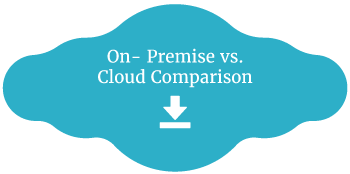It will take a collaborative effort between your business, the vendor, and an implementation partner (in many cases) to achieve these goals. We want to look specifically at the ever-changing relationship between your business and the many software vendors you interact with every day. These insights can lead to a smoother transition to the cloud or serve as a barometer for measuring the value and risks you accept with your cloud-based providers.
Software vendors have always played an integral role in your business. As the world moves toward cloud-based solutions, these vendors play a different and even larger role. Before this evolution toward the cloud, a solution provider would install an instance of its software on your IT infrastructure that was completely customizable, given the right IT resources.
This often led to overly customized and outdated business solutions because companies would rather invest in minor enhancements than in complete solution overhauls. The vendor was there for the initial implementation and major upgrades. But the organization never really felt like the vendor was there for every step of the journey as its business needs evolved.
In the last decade, however, enterprise application providers had a brilliant idea. They would deliver extremely configurable systems that follow industry and functional best practices on a subscription-based model. These solutions would not be blocked to the market by complex IT hardware requirements for their customer base. Also, there’s the added benefit that solution fixes and enhancements can be pushed to their entire customer base at the same time. The challenge is that the solutions are not overly customizable for each customer to meet their specific and ever-evolving business requirements. With this updated model, the vendors realized they didn’t need to be around for every step of the journey.
Theoretically, the benefits to this cloud-based solutions model make perfect sense. Making the transition to the new model will require a shift to ingrained behaviors between an organization and its outside vendors. What challenges await organizations that are moving to the cloud? And how can they develop a more strategic partnership with their vendors to tackle those challenges?
But First, What Does It Mean to Be a Strategic Partner?
A strategic partnership is an arrangement between two organizations to help each other or to work together. Such an arrangement makes it easier for each party to achieve the things they want to achieve. Simply put, your business should work with its software vendors to mutually achieve goals. The goals of the two parties may be different, but closely aligning with your partners will only aid in making both of you more successful. With that definition of a strategic partnership in mind, here are three key themes to optimize your journey in the cloud and solidify your vendor relationships:
- Product roadmap and release collaboration
- Data ownership and security
- Services levels and support
Product Roadmap and Release Collaboration
With the move to the cloud, a whole new set of unique solution opportunities and challenges could affect your organization. In the past, developers could customize applications to build out functionality within a single instance of the software solution on your contained IT infrastructure. With cloud-based solutions, unique business requirements are handled either through configuration, light customization (not in the traditional, on-premises ERP sense), or as an addition to the future product roadmap by the vendor.
This is where your relationship with the vendor is so important. Having a seat at the table is crucial to influencing the direction of the solution and meeting your evolving business needs. This means you need a collaborative, strategic, and respectful relationship with your vendors to understand their value proposition in evolving the product to fit your business needs.
Perhaps solving for an industry-specific need for your business does not align with their market strategy. In that instance, you may have to pay the vendor to advance the development timelines of your requested features or integrations. With all their customers sharing the same base solution, your requests must now be weighed against requests from all their other customers.
Another shift you will see: Release schedules for cloud-based solutions are no longer the responsibility of your internal IT organization, which can create IT release planning challenges to your business. Also, the rigor behind testing vendors’ products prior to new releases can vary widely from vendor to vendor. That means major bugs could be released into your production environments.
How to Approach Product Roadmap and Release Collaboration
Have early conversations with your vendors about how you can influence their product roadmap. You may want to lay out certain terms in your contract around how and when your requested features will get implemented into future product releases. Establish guidelines around how their team will partner with you on future requirements. This will help prioritize your requirements and the requirements they receive from other clients. This may be a service that comes at an additional cost, but the improved response to your solution requirements will pay off in the long run.
Creating open lines of communication to present your business case for new requirements and to influence the future of the product you purchase is huge in the cloud world. Look for opportunities to serve as a use case, so your vendor can prove its solution within your industry or within a new capability. Often, these vendors will choose to operate at a loss to get their foot in the door if you are willing to be an early adopter for a new market for their product.
Be sure to establish clear guidelines around how early the vendor will communicate release schedules and functionality to your IT department. Ensure enough lead time to identify possible collisions and communicate appropriately to your business users. Service-level agreements should address how quickly defects (critical and noncritical) from each release are fixed.
Data Ownership and Security
With cloud architecture, you may face new challenges around leveraging data for other uses and protecting data now residing within a vendor’s cloud solution. Who really owns the data? Who is liable in the event of a security breach? Working with the right vendor under the right agreement terms can lead to a strategic advantage for your organization.
As the ability to draw business insights through data analysis has increased, the value of data has greatly increased. Many cloud-solution providers recognize that there are opportunities to aggregate anonymized data and then monetize the insights developed from that data. Everything is up for grabs, from data about your customers to user behaviors across interactions within the solution.
Vendors vary in how they promise business continuity, data privacy, and disaster recovery. Therefore, you must make sure their certifications and redundancies meet your security requirements. As end-to-end solutions become more integrated across multiple vendors, as well as your own IT infrastructure, loopholes in liability can quickly present themselves.
How to Address Data Ownership and Security
Prior to entering negotiations with any vendor, understand the market value of the data you will share with your vendors. First, ensure your contract language protects the data privacy of your customer base. Always start negotiations with the stance that you fully own the data. Even if your company does not have plans to monetize the data, you can always leverage the use of the data to drive better pricing or even an annuitized share of profits made from the use of the data.
Cloud providers often invest large sums of money into their security infrastructure—meaning the security standards around their products could trump your company’s standards. Companies have a vested interest in keeping your data secure; the harm from one breach would seriously damage customer relations.
But, even though the security practices of your vendors are well-stated and certified, you can do more to minimize risk for your organization. Assigning specific liability penalties in the event of a security breach will ensure your company is made whole from damages related to a breach. Crisply define the scenarios that drive liability, which could depend on the sensitivity of the data and the complexity of the integrated solution. Request a cadence of security performance reports—another best practice. If you give your vendors clear requirements and expectations around security, you should have nothing to worry about. In fact, you may end up reducing the risk of exposure across your business solutions.
Service Levels and Support
With the move to the cloud, your interactions with your vendor will completely change. From scheduled refreshes of the environment to system bugs, you will be much more dependent on your vendor. Vendor performance is a key attribute of the strategic partnerships you will look to develop. This is defined as a vendor’s ability to respond quickly to defects within its solution—as well as its ability to cater to your evolving business needs.
Establishing the guidelines for how you expect your vendors to perform ties in to how you intend to track them against those performance expectations. Consider these questions when laying down service-level agreements:
- What does the vendor’s account management structure look like? Are the right stakeholders from their side ready to build a relationship and be accessible when needed?
- Do we have transparent communication back and forth—even in tough situations? What is the channel through which we communicate on critical and noncritical defects? What is the expected response time in these situations?
- How should you rate your satisfaction with the vendor’s support and use it when discussing future goals?
- Is the vendor willing to negatively impact its own revenue to improve its partnership with you as a client?
- Is the vendor open to outcome-based pricing (e.g., variable price based on system performance)?
Lastly, with the speed to market of new cloud solutions, it can be difficult to find quality resources in the market to support the technology. There will be a skills gap that will require creative talent sourcing on your end.
- What does the support model look like? Who should own L1, L2, and L3 support?
- Does the vendor recommend any third-party vendors as a preferred partner to provide support?
- Does the vendor offer training and conferences that enable you to grow the internal capabilities to most effectively use and support the vendor’s solution internally?

How to Address Service Levels and Support
To eliminate the risk of poor responsiveness from vendors, negotiate a master services agreement, including service levels with clear performance indicators that align to vendor responsiveness. Establish a vendor management approach focused on identifying and resolving risks related to vendor responsiveness. Centralizing your vendor management function with a defined approach for tracking performance will enable you to see a more holistic picture of your vendor relationships.
On the solutions that are most critical to your business, set a cadence of touchpoints to communicate the vendors’ performance, which can hold your vendor accountable with clear expectations, incentives, and penalties. Any critical issues should be resolved with a clear approach and timeline that is agreeable to both parties before levying any contractual penalties.
The steady-state support approach should be understood prior to entering any cloud-based vendor relationship. Newer vendors will often be the only source of technical expertise, so you should feel confident in their ability to handle anticipated support volumes. Or, find a third-party provider who can own ongoing support so you can fully understand the total cost involved with the steady-state solution.
Lastly, consider the vendor’s performance in the cloud-based solution—and its support of the solution—during any extension or renegotiation. Gather feedback from everyone who interacted with the vendor and solution to account for any aspect of performance that was included within the original agreement. Reward good performance with additional opportunities to solve for other business needs. Address poor performance with an opportunity to repair the relationship—either through increased service or reduced prices.

